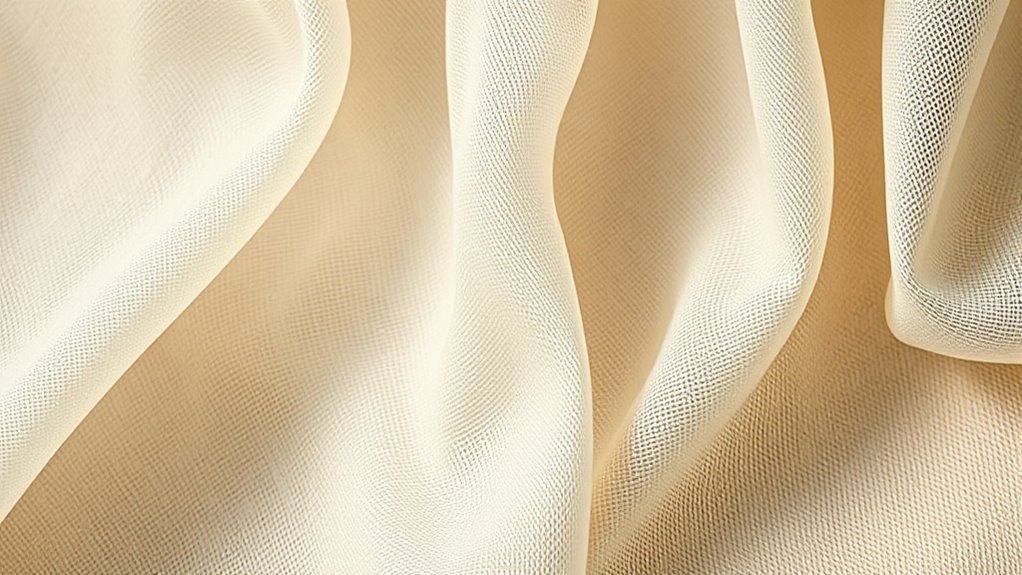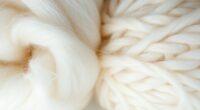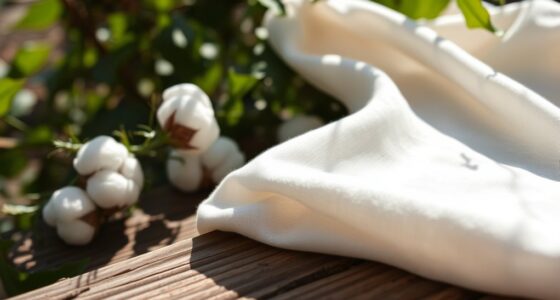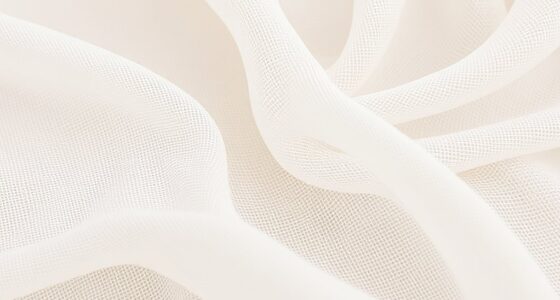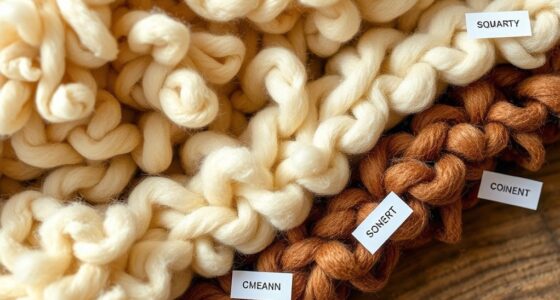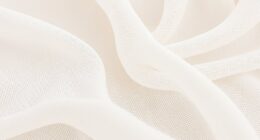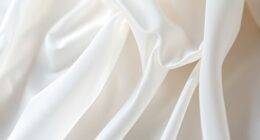Discover Cupro, a luxurious, eco-friendly fabric made from regenerated cellulose sourced from cotton linter, a cotton byproduct. It offers a silk-like feel, drapes beautifully, and is breathable with moisture-wicking properties. Its production focuses on sustainability, using environmentally conscious practices that reduce waste and chemical use. As a biodegradable fabric, Cupro supports responsible fashion choices. To learn more about its benefits and manufacturing, keep exploring how this innovative material is shaping sustainable textiles.
Key Takeaways
- Cupro is a regenerated cellulose fabric made from cotton linter, offering an eco-friendly alternative to traditional textiles.
- Its production involves dissolving cotton linter in a viscose process, using environmentally conscious practices to minimize waste.
- Known for its silky texture, breathability, and moisture-wicking qualities, making it suitable for various clothing styles.
- It promotes sustainable fashion by supporting ethical manufacturing and reducing chemical use in production.
- As a biodegradable fabric, Cupro helps reduce textile waste and aligns with environmentally conscious consumer values.
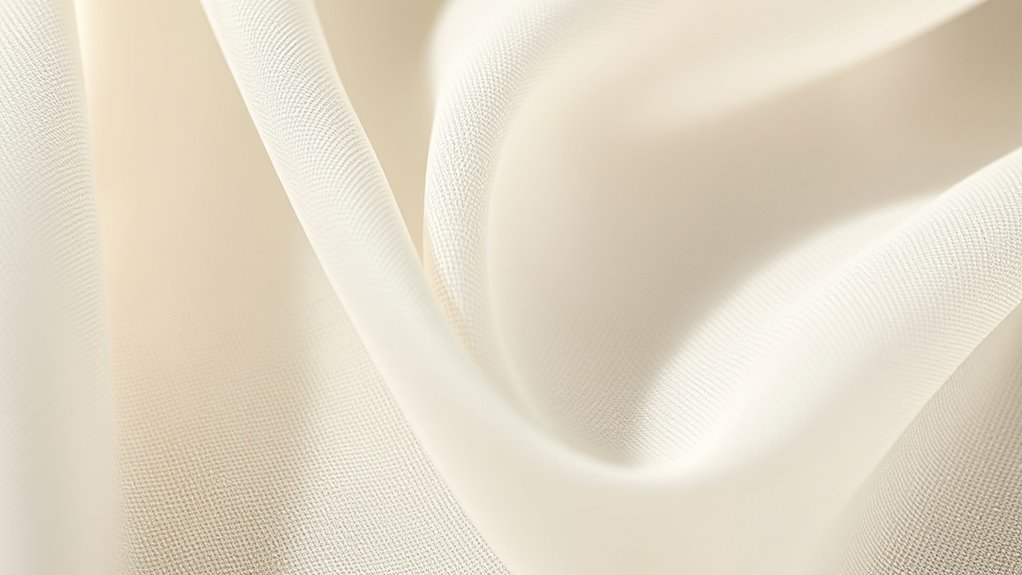
Have you ever wondered what makes cupro a standout fabric in the world of sustainable textiles? If you’re passionate about sustainable fashion, understanding how cupro fits into this movement is key. Unlike conventional fabrics that rely heavily on resource-intensive processes, cupro is a regenerated cellulose fiber made from cotton linter, a byproduct of fabric manufacturing. This means it repurposes waste material, making it an eco-friendly choice for those seeking to lessen their environmental impact. As a part of sustainable fashion, cupro offers a compelling alternative to more pollutive textiles, thanks to its biodegradable nature and the environmentally conscious methods used in its production.
Cupro is a sustainable, biodegradable fabric made from cotton linter, repurposing waste and reducing environmental impact.
During fabric manufacturing, the process of creating cupro involves dissolving the cotton linter in a viscose process, then extruding the solution through spinnerets to form fibers. This process is carefully controlled to minimize waste and reduce chemical use, especially when compared to traditional textiles like polyester or nylon. Many manufacturers now prioritize environmentally friendly practices, employing closed-loop systems that reuse chemicals and water, further reducing the environmental footprint of fabric manufacturing. As a result, cupro’s production aligns with the principles of sustainable fashion, emphasizing efficiency and responsible resource management.
Once produced, cupro’s qualities truly make it a desirable fabric for eco-conscious consumers. It has a silky smooth texture, drapes beautifully, and feels luxurious against the skin. Its breathability and moisture-wicking properties make it suitable for a wide range of clothing, from blouses to dresses, appealing to those who want comfort without sacrificing style. Because it’s derived from cellulose, it’s biodegradable and breaks down naturally in the environment, unlike synthetic fibers that persist for hundreds of years. This biodegradability enhances its appeal within sustainable fashion circles, where reducing long-term waste is a priority.
Moreover, cupro’s production supports ethical fabric manufacturing practices. Many brands now source cupro from factories that adhere to strict environmental standards, ensuring fair labor conditions and reduced chemical use. This commitment to sustainability and ethics resonates strongly with consumers who want their fashion choices to align with their values. As awareness of environmental issues grows, more designers incorporate cupro into their collections, championing its eco-friendly credentials while delivering stylish, high-quality garments.
In addition, the development of cupro exemplifies how regenerated cellulose fibers can be produced sustainably by utilizing waste materials and environmentally conscious manufacturing methods. It demonstrates how fabric manufacturing can evolve to meet the demands of a greener future. By choosing cupro, you’re supporting a movement toward more responsible fashion—one that values both style and sustainability. This fabric represents a step forward in reducing textile waste and chemical impacts, making it a smart choice for anyone committed to making a positive environmental difference through their wardrobe.
Frequently Asked Questions
Is Cupro Suitable for People With Sensitive Skin?
Yes, cupro is suitable for people with sensitive skin because it has hypoallergenic properties that reduce the risk of skin irritation. The fabric’s smooth, soft texture minimizes friction, making it comfortable to wear all day. You’ll find that cupro’s natural fibers are gentle on your skin, helping to prevent allergies and irritation. So, if you’re prone to sensitive skin, cupro could be a great, comfortable choice for your wardrobe.
How Does Cupro Compare to Other Eco-Friendly Fabrics?
Like a chameleon blending into its surroundings, cupro seamlessly compares to other eco-friendly fabrics. It offers notable sustainability benefits, such as biodegradability and less water usage during production. Its environmental impact is lower than synthetic fabrics, making it an excellent choice for eco-conscious consumers. While each fabric has its strengths, cupro’s silky feel and eco-profile make it a compelling option, supporting your efforts to choose sustainable, gentle materials.
Can Cupro Be Recycled After Disposal?
Yes, you can recycle cupro, but recycling challenges exist due to its chemical treatment process. The environmental impact of recycling cupro is generally positive, as it reduces waste and conserves resources. However, because of its delicate fibers and chemical residues, it’s not always straightforward to recycle. Still, choosing to recycle cupro helps minimize landfill waste and promotes sustainable fashion, making it a good eco-friendly option when proper recycling methods are available.
What Are the Best Care Practices for Cupro Garments?
Caring for your cupro garments is like tending to a delicate flower—you want to keep them looking fresh. Always hand wash or use a gentle cycle with cold water, avoiding harsh fabric dyeing chemicals. Hang dry or lay flat to maintain their silky sheen. For garment maintenance, steer clear of high heat, and store them in a cool, dry place. Proper care guarantees your cupro pieces stay beautiful longer.
Is Cupro More Expensive Than Traditional Silk?
You’ll find that cupro is generally less expensive than traditional silk when you look at fabric pricing and cost comparison. While silk is considered a luxury fabric with higher prices due to its natural origin and labor-intensive production, cupro offers a similar smooth, luxurious feel at a more affordable cost. This makes cupro a great alternative if you want the elegance of silk without the higher price tag.
Conclusion
Now that you’ve explored the delicate, draping world of Cupro, you can appreciate its eco-friendly elegance and exquisite softness. With its sustainable story and silky-smooth surface, Cupro combines comfort and conscience effortlessly. So, next time you choose a charming, chic fabric, consider the mesmerizing, conscious qualities of Cupro—crafted from cellulose, created with care. Embrace this eco-enhanced fabric and enjoy fashion that feels fabulous and environmentally friendly, all at once.
